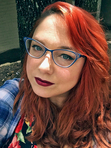E. Kristin Anderson's Blog, page 20
June 14, 2014
Pride Week Guest Post from Juliann Rich: Secret Confessions from an Ally — On Wrestling with Privilege
Okay, I admit it. I was scared to write CAUGHT IN THE CROSSFIRE, a book about a sixteen-year-old boy who falls in love with another boy…at Bible camp.
That’s right. Scared.
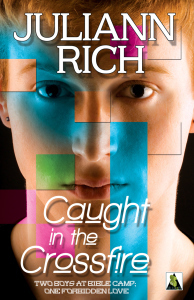
Bold Strokes Books, June 2014.
But not about whether ultra-conservative Christians would get upset with the book (or with me for writing it). No, I tossed and turned, night after night, worrying I’d mess up the story and inadvertently hurt or offend the LGBTQ community.
Hit PLAY on the Track marked “Internal Critic, Part I” and dated Fall, 2011: Why don’t you write that nice mystery you’ve been dreaming about instead? The one with the straight, white, forty-five-year old woman detective with the dachshund sidekick. Yeah, that’s the book for you.
Stop. Rewind. Replay (about 754 times).
See, I couldn’t argue with the logic of that message. If write what you know is true, then I—a straight, middle-aged woman—had no business writing a book from the perspective of a gay teenage guy.
Or did I?
Jonathan Cooper, my main character in CAUGHT IN THE CROSSFIRE, certainly thought I did. He came to me in all the quiet spaces of my life and even barged into the noisy ones, wielding that rare form of tenacity that is usually reserved for campaigning politicians. Seriously. The kid was relentless.
Then there was the matter of my reaction to Jonathan Cooper’s story. I’d raised a wonderful young man who happens to be gay. I love him dearly. I was raised by evangelical Christian parents. I love them dearly. This story touched the deepest places of my being—the ones that have defined me the most—and left me feeling that it was not only something I could write, it was something I had to write.
I determined to give it a try and wrote a first draft, which succeeded in living up to all purposes and predictions of first drafts. In other words, it told the story, but it stunk. I had the plot, but the prose was too lyrical. The voice was too old. And the third person point of view that felt, somehow, literary? Yeah, that had to change. If I was going to do this story justice, I knew I had to close the distance between my Jonathan and myself. I needed to feel his pain.
But therein was the problem. I hadn’t felt his pain.
I hit a wall. Oh sure, it was bricked up with good intentions: the desire to be respectful; the desire to be accurate; the desire to not appropriate someone else’s culture, history, reality. But it was still a wall, and it was stopping me from doing the important work I felt called to do.
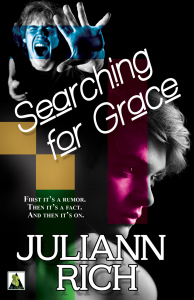
Bold Strokes Books, September 2014.
Hit PLAY on the Track marked “Internal Critic, Part II” and dated Winter, 2012: Who do you think you are, tackling a story like this? What exactly do you know about being a teen guy, much less being a gay teen guy?
Stop. Rewind. Replay (about 1203 times).
Who do you think you are? Good question, huh? The answer was more complicated than I realized when I started writing CAUGHT IN THE CROSSFIRE. I knew who I was: a straight, white, cisgendered, able-bodied, forty-five-year-old woman in a hetero-/cis-normative society. While I’ve stood by my son as he has fought against prejudice and discrimination because of his sexual orientation, I have never personally experienced such things. I’ve never been the brunt of a homophobic slur. I’ve never been told I can’t marry the person I love. I’ve never worried about whether it was safe or socially acceptable to hold my husband’s hand in public or give him a kiss goodbye. In short, the more I sought Jonathan’s emotional truth, the more I smacked into the hard, undeniable wall of my privilege…and the more I wondered whether I had the right to tell his story at all.
But I was also a writer with a story that was demanding to be told, facing the epic question of whether or not I was the right person to write the book. I dove back into CAUGHT IN THE CROSSFIRE, uncertain of but committed to discovering the answer to that question.
The first step required me to become a method actor. If I was going to write Jonathan, I had to become Jonathan. I was surprised to find that shedding my female old-fogeyness and peering through Jonathan’s eyes was much more fun and freeing than I thought it would be, even if what he and I sometimes saw together was not pretty. Jonathan taught me a ton throughout writing CAUGHT IN THE CROSSFIRE and even more in SEARCHING FOR GRACE, the sequel that will be released through Bold Strokes Books in September 2014. He taught me about the rare form of courage it takes to choose authenticity over acceptance. He taught me about the sting of pain for being judged not for what you’ve done, but for who you are. He taught me how to take the next step and ask for help when my imaginative abilities reached their limits.
With Jonathan’s encouragement, I reached out to my son, to my son’s friends, to their friends. I asked them questions and they told me their truths, their secrets, their shame, their fears, their triumphs. They kept it real. They kept me honest.
In the end, I did finish CAUGHT IN THE CROSSFIRE. It is currently available through Bold Strokes Books and everywhere books are sold. I am so thankful I let Jonathan lead me through this venture. He taught me about pain and privilege. He taught me to weigh every word carefully, in my writing and in my day-to-day conversations, for words possess both the power to create worlds and destroy lives. More than anything, he taught me that when I affirm others, I am also affirmed.
This, of course, has sparked a new track that plays in my mind these days, and it goes a little like this…
Hit PLAY on the Track marked “Secret Confessions from an Ally” and dated Summer, 2014: I’m a person with privilege I didn’t earn and don’t deserve any more than anyone else. I am also a writer. I have a voice I want to use to tell stories for the community and the people I love. I may get it wrong. I will get it wrong. But there are people with first hand experience—wonderful and generous beta readers—who will keep me honest and accurate. Even so, I will be afraid, but that’s no reason not to do this work I love.
Stop. Rewind. Replay.
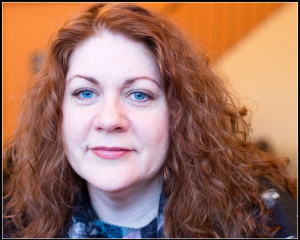
Juliann Rich.
Minnesota writer Juliann Rich spent her childhood in search of the perfect climbing tree. The taller the better! A branch thirty feet off the ground and surrounded by leaves, caterpillars, birds, and squirrels was a good perch for a young girl to find herself. Seeking truth in nature and finding a unique point of view remain crucial elements in her life as well as her writing.
Juliann is a PFLAG mom who can be found walking Pride parades with her son. She is also the daughter of evangelical Christian parents. As such she has been caught in the crossfire of the most heated topic to challenge our society and our churches today. She is drawn to stories that shed light on the conflicts that arise when sexual orientation, spirituality, family dynamics and peer relationships collide. You can read more about her journey as an author and as an affirmative mom on her blog, The Rainbow Tree.
Juliann is the recipient of the 2014 Emerging Writer Award from the Saints and Sinners Literary Festival for her debut novel, CAUGHT IN THE CROSSFIRE (Bold Strokes Books, June 16th, 2014). She lives with her husband and their two dogs in the beautiful Minnesota River Valley.
You may stay in touch with Juliann via her website: www.juliannrich.com or email at juliannrichbooks@gmail.com.





June 13, 2014
Pride Month Guest Post from Annameekee Hesik: Worst Gay Pride Day, Like, Ever.
In honor of Pride Month, I thought I’d tell a little tale about the worst Gay Pride Day I have ever experienced. I was seventeen and I was out and proud, but also still really naive and really excelled at making bad decision, as evidenced by the painful details below. Names, dates, and locations have not been changed because, let’s face it, there were no innocent people involved.

Annameekee in her senior year high school sports pics. Note the fairly clear, yet paper white skin.
Picture it: Tucson, Arizona, June 3rd, 1993. The temperature was already sneaking past 100 degrees and it was only 11:30AM. My girlfriend, Amy, and I claimed a patch of yellow grass with a view of the dance area and spread out our towels. Life as I knew it right then, at age seventeen, was good. Thanks to Cindy Crawford’s Shape Your Body VHS workout tape, my body was slamming- abs flat and tight and not an ounce of flab to be seen bulging out of my tiny white bikini with ruffles. Man, I loved that bikini. Not only was I rocking a fit body, Amy and I had been dating for about six months and as far as I knew, things were great. I was her “first lesbian” as she noted on our first date, so that meant I was finally the one calling the shots. No more older lesbians who knew all the ropes and consequently tied me up in those ropes (metaphorically speaking, of course). Amy and I met on the basketball court. We were on rival teams and played defense on each other with too much groping and not enough concentration on the game. It was love at first flirt, as lesbians tend to do. We had a long, wonderful summer ahead of us until I moved up to Washington to attend Seattle Pacific University where I had barely been granted admission. To top it all off, thanks to a new prescription drug called Accutane, I finally had a face free of the cystic acne that had plagued me all through high school. “Life is good,” I thought as I applied my SPF 4 suntan oil, reclined on my towel, and made myself comfortable, yet appealing, just in case any of those crazy exes walked by. Naturally, I wanted to look my best so they would feel great regret in screwing me over.
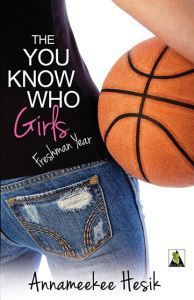
Bold Strokes Books, October 2012.
Tucson’s definitely got one of those Big City, Small Town feels to it, especially at gay events, so it wasn’t too long before someone I knew walked up. Anita was never an ex, and I was proud of that for some reason- not that I was a slut or anything. She was a close friend of one of my exes and that’s how we became sort of friends. She did, however, have a very obvious, kind of bothersome, crush on me, so I wasn’t that excited to see her. When she squatted down to say hi, I introduced her to my new girlfriend. “Hey,” they both said and nodded to each other. Then I saw an opportunity to temporarily get rid of them both. Not that Amy was getting on my nerves, but I wasn’t in the mood for small talk and I was getting thirsty. “Get me a water, babe? Can you show her where they are, Anita?” Amy jumped up, eager to walk around since it was her first Gay Pride and followed Anita to the concession stands. I leaned back again, enjoying the warmth of 110-degree sun on my body. They returned quickly and said that there were some t-shirt booths they wanted to check out. “Yeah, sure. Have fun,” I said confidently and waved them off.
About an hour later, a woman I didn’t know tapped me on the shoulder. “Hey, do you want some sunscreen?” I sat up and looked down at my exposed stomach, still flat and slightly pink. “No, I’m fine, but thanks.” The woman shrugged and walked off. About twenty minutes later I heard, “Oh damn,” which I took as a compliment, but then it was followed by, “That shit’s gonna hurt tomorrow.” I waited until she passed and then sat up and took off my sunglasses. Hmm…maybe I had been out a little long. Maybe it was time we pack up and head home or at least move the towels to the shade. But, this was before cell phones were common and were smaller than bricks, so there was no way of telling Amy that I was moving. I didn’t want her to worry. Where was she anyway?
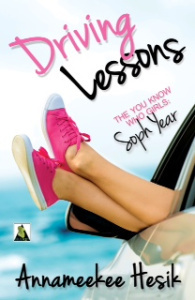
Bold Strokes Books, December 2014.
An hour later, Anita and Amy finally made their way up the hill, laughing and having a gay ol’ time. I was happy Amy had a new friend, but declared that it was time to go. One look at me and they made a face like I had a contagious flesh eating disease and agreed, yes, it was time I get inside.
Since I had finally come out to my mom and step-dad, girlfriend sleepovers were denied (one reason NOT to come out to your parents). Therefore, it was off to Amy’s because she wasn’t out and nothing brings a close to a Gay Pride Day like having a silent and awkward make-out session in your girlfriend’s twin bed with her mom in the next room. Her mom, Diane, hated me with a deep passion. I believed at the time that it was because I ate all of her Weight Watchers cheese slices, but now that I think about it, it was probably because I was dating her closeted daughter and doing more-than-friends things with her in the room next to hers. Anyway, after an hour of watching Amy play Nintendo (the Nintendo I bought her for our six month anniversary), the pain of the sunburn intensified and I was in incredible agony. I started to shake and cry. There was no comfortable position or relief- no amount of aloe was going to fix what I had done. Amy drew me a cold bath, but after sitting in it for two minutes, the water turned warm and the pain returned. I tried to dry off with a towel but it felt like I was rubbing a cheese grater on an open wound. My sunburn was beyond anything I’d ever experienced in my life. Where did I go wrong?
Turns out that Accutane had tried to give me a heads up on this very issue. After all, the prescription did come with a warning that the medication may cause “increased sensitivity to the sun.” But, like I said, I was seventeen. I had also been warned not to get in a car with someone who had been drinking and to not intentionally foul a girl on the court, but so far I was getting away with not following many rules, so I disregarded the warning on my bottle of pills, too.
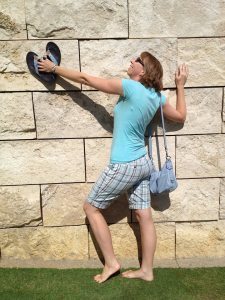
Annameekee pretending to be an ancient Greek warrior with flip flop weapon. What you can’t see is that she is wearing SPF 35 all over her body.
Early the next morning Diane gave me a ride home. Amy sat up front as I winced and grimaced in the backset after every bump, brake, and acceleration. I swear I saw Diane maliciously grin after she abruptly stopped at a yellow light. My mom screamed when she saw me and then promptly called Ask-a-Nurse for advice. Thin pieces of cloth soaked in cold milk were draped all over my body for the next three days. Since I was suffering from second-degree burns, as soon as the milk wraps hit me, they would heat up quickly. Consequently, I reeked like baby spit up. The first couple of days, I was just really, really red. Then the blisters came. Some were the size of sand dollars, and if I moved they would burst and ooze fluid down my chest. My forehead was so severely burned that I could no longer feel it. Even the tops of my toes were blistered. My body spent the next two weeks working overtime to regrow skin and for what? Not even one of my exes saw me in my bikini. What a waste.
And that wasn’t the end of the worst Gay Pride Day. Oh no. It turns out that the friendship that quickly brewed between Anita and Amy was more than what it seemed. A few months later I found out that they were MIA for so long because they were making out in Anita’s truck while I baked like a cookie on the lawn. Classic. I sure knew how to pick them back then.
Hands down, the worst Gay Pride Day, like, ever. * **
So to all you little gaybies enjoying the Gay Pride events out there, learn from my bad example: keep your girlfriend or boyfriend close, and for god’s sake, wear some sunscreen!
* A few years later, I found out that the Tucson Gay Pride Day was moved to October. I like to think that the image of my charred white-girl body left an impression on the planning committee and helped them to decide to shift the day to the cooler, less hellish month. You are welcome, Tucson.
** I ended up dating Anita. That’s how I found out about the make out session she had with Amy. Naturally, after hearing that news, I stayed with Anita for a long regrettable year. I blame the sunburn, which clearly further diminished my ability to make good decisions.
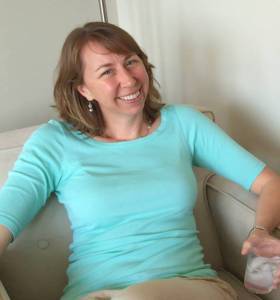
Annameekee Hesik.
Annameekee Hesik grew up on a healthy diet of Pippi Longstocking movies, Fig Newtons, and Schwinns. Too tall for most backseats, she spent her teen years playing basketball and wearing high waters. She now teaches English in Northern California and writes the books she wishes were around when she started falling for girls in high school. Her YA novel, The You Know Who Girls, is available in bookstores and online now, and its sequel, Driving Lessons, is slated for release on December 1st, 2014. She is the youngest of seven girls, enjoys gummy vitamins and her beverages ice cold, and wears lavender-scented sunblock and a hat every time she goes outside. Find out more at and on Facebook: Annameeke Hesik (YA Author)





Pride Week Guest Post from Sarah & Ian Hoffman: The Road We Travel
We have a teacher friend who’s been an long-standing champion for inclusiveness. Thirty years ago she was a founder of an excellent progressive school in the Bay Area. This teacher was recently reviewing the school’s charter, where she noticed it said the school would provide an “excellent education for boys and girls.”
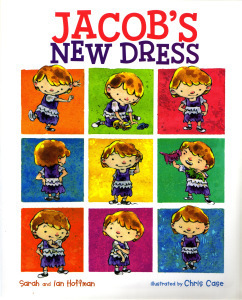
Albert Whitman & Company, March 2014.
“We wouldn’t write that today,” she said. “We wouldn’t get stuck in that binary way of thinking. Back then the idea was we would provide an appropriate education for boys in a coed environment, and an appropriate education for girls in a coed environment. Like there were boy brains over on this side, and girl brains over on that side. It never quite made sense to me, but that’s where educational theory was back then.”
Two recent interviews, one on NPR and the other in the New York Times, show how much thinking has changed in thirty years.
Famed British comedian Eddie Izzard–who used to perform in full drag–charmingly explained his take on clothes, gender, and sexuality on a recent NPR Morning Edition interview. Among the highlights was this exchange:
NPR: “Can I ask you something that we don’t normally ask our guests at Morning Edition, even when they’re in another office? You’re in our New York bureau. I’m in Washington. I can’t see you, but can you tell me what you’re wearing today for the interview?”
Izzard: “Ah, mainly clothes. Mainly clothes.”
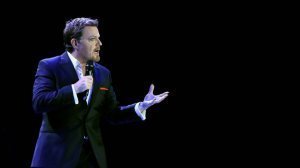
Eddie Izzard.
NPR: “That’s–that’s good.”
Izzard: “You’re trying to go down this transvestite line, but you wouldn’t ask Hilary Clinton that. So that’s why I’m going to keep…. I’m just wearing clothes, whether any of it’s supposed to be men’s clothes or women’s clothes, I don’t agree with that–that thing. I think the United Nations should have something in there that says you can wear what the hell you want to.”
NPR: “That’s fair enough. Fair enough.”
Izzard–a self described “straight transvestite”–talked about how his appearance has little to do with what he’s capable of as a performer. “[T]here’s a big slice of boy genetics going on in me, plus the extra girly genetics. It has nothing to do with the comedy. My comedy is my comedy. My drama is my drama.” He continued that transgender needs to get to the status that gay currently enjoys: “boring.”
The topic of gender dealt with, Izzard and NPR went on to a long discussion about Izzard’s current work and the business of being funny.
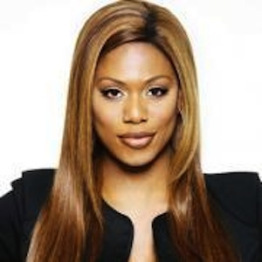
Laverne Cox.
Laverne Cox, a transgender actress starring in “Orange is the New Black,” touched on similar topics in a recent New York Times interview.
NYT: Sophia is the first transgender person a lot of audiences will be exposed to, and she’s in prison. Do you worry that’s sending the wrong message?
Cox: I think our show really makes it explicit that just because someone is incarcerated does not mean they are no longer a human being. We can’t talk about America without talking about this. We incarcerate more people than anybody else in the world. I’m not interested in this false dichotomy around positive versus negative representation. It does not allow for the complexity and the nuance and the full humanity of character.
NYT: Is it a burden to be known as a transgender actress–not just an actress?
Cox: Yeah, but at the same time I think it’s important to empower being trans. Most of the narrative around trans identity has been about transitioning. You blend in, and that is the goal, but blending in was never an option for me. Some people are going to know that we’re trans. There’s nothing wrong with that.
NYT: Will we live to see a day when there’s a transgender crime-scene investigator on a “C.S.I.” spinoff?
Cox: This is my dream! This is my dream! I actually believe it is possible.
From boy brains and girl brains to considering the possibility of a trangender C.S.I. crime-scene investigator. It was just a decade ago when our son Sam, aged two, found his love for what are generally considered “girl things.” First pink sneakers, then pink t-shirts, then princess dress-up costumes and tiaras and fairy wings. For some time, we were the only parents we knew with a boy like this, and Sam was certainly not reflected in popular culture in any positive way. Now we have Eddie Izzard and Laverne Cox expressing thoughtful and nuanced positions about gender where everyone can hear them.
This June, it’s good to pause and see how far we’ve traveled on the road to acceptance. There’s a long ways to go, but we’re definitely on our way.
Happy Pride Week!
-Sarah & Ian Hoffman
Sarah and Ian Hoffman are the parents of a pink boy and a girl whose favorite color is yellow. Sarah writes for national magazines, newspapers, and radio, and speaks publicly about raising her gender-nonconforming son. Ian writes children’s books. They use pseudonyms to protect the safety of their family.





June 12, 2014
Pride Week Guest Post from Ellen Larson: Diversity and the YA Mystery
Stats don’t lie
As someone with more than a passing interest in young adult fiction, I ran across a compelling article by Malinda Lo last fall called “Diversity in ALA’s Best Fiction for Young Adults.” Among other stunning stats was this nugget about racial diversity: Less than 20 percent of the characters in YA lit were kids of color. On the other hand, according to some non-literary news that had come out the previous year, for the first time in history the total number of non-white babies born in the U.S. was more than the total of white babies born. I read another survey that said the number of non-white protagonists (as opposed to characters) in YA fiction in a recent year was only seven percent. For me, this was something to chew on: the majority of today’s generation is non-white, but the books we are busy writing for them overwhelmingly feature white characters.
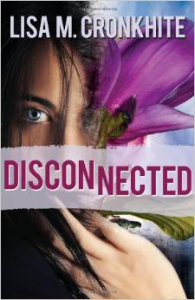
The Poisoned Pencil, June 2014.
I don’t know enough about it to discuss why this is so, or to guess at what underlying sociological factors cause this disparity. But, as luck would have it, I am in the unique position of being able to do something about it—in a small, probably-nobody-will-notice-but-us-but-at-least-we’re-doing-something sort of way. I am the editor of the Poisoned Pencil the new young adult mystery imprint of Poisoned Pen Press), We are a tiny imprint–we only plan to publish four titles a year for our first couple of years–but thanks to the distinctive leadership style of publisher Robert Rosenwald, we are as free-wheeling as it gets. He may yet regret the day he said to me, in response to my warning that I had ideas about such things, “Pick the ones you like; who cares what anyone else likes?” NB Yes, I live a charmed life.
The Poisoned Pencil
That was in the summer of 2012, when we set out to define our brand. We decided to more or less avoid books with a supernatural element, because that’s what everyone else was doing. I’d rather rot in hell that work with those “mean girls” sorts of books, which anyway tend to be badly plotted and shallow. We wanted something serious with message. We called it “creepy” or “le creep”—until people started thinking we were doing horror, then we pulled back to “edgy” and “relevant.” And in my head I wondered how I would deal with the diversity issue.
To me, continuing the trend of publishing YA books with WASP protagonists would be a huge disservice to the literary community. I happen to be one of those people who believe that the best writing says something; in fact, every time you write something you’re saying something. Even if you don’t know it. So you better pay attention to what you’re writing. The point is that writing books that underrepresent minorities is saying something. And it’s not something I care to say.
But I digress
The stats in Melinda Lo’s article tell a similar story of under-representation when it comes to gender diversity and characters with disabilities. In fact (my favorite stat), the number of YA books featuring LGBTQ protagonists in 2013 was two percent. Note that there is a huge difference between being a character and being a protagonist in a book. In fact, it is clear that YA fiction suffers from Minority Sidekick Syndrome, itself a well-known form of prejudice.
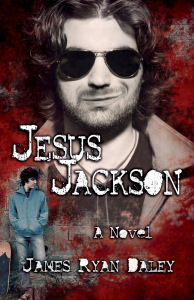
The Poisoned Pencil, September 2014.
The submissions I’ve seen in the past two years at the Poisoned Pencil bear this out in spades. Every white protagonist has a Hispanic, or African American, or gay, or disabled best friend or love interest (which I guess is a step in the right direction). These characters were written with an absence of self-consciousness that was quite pleasing. But eighty percent of the protagonists were WASPs.
For a while I worried that I would end up passing on a great book with a white protagonist; that I would lose my literary way in my quest for diversity. But as it has turned out, there has been no problem. I am primarily looking for books written with an original voice, and so far it seems that those are also the books that reflect the sort of diversity I’d hoped to find. Indeed I something think I sound like a suburban club wife who boasts that she has friends/books that are African American, Native American, atheist, Hispanic, and mentally ill. (Note to self: try to be cooler.)
Even though I’m happy with the new list from the Poisoned Pencil, I want more. The field is staggeringly, cavernously open. Where is the YA mystery with the protag who is Muslim? Where is the teen dreamer, who would love to go to the cops to help solve a crime, but is afraid of being deported? Boy, that sure solves the perennial problem of having to explain why the amateur sleuth doesn’t go to the cops, doesn’t it! Where is even one LGBTQ protagonist? Just as a character choice—I don’t need or necessarily want a YA mystery with a heavy LGBTQ theme (you tend to end up with too much going on). Though to be sure there are LGBTQ protagonists out there in YA mystery fiction (check out the works of Greg Herren), my submissions inbox at Submittable remains empty of such treats.
What’s the hold-up?
The problem can be directly traced to the fact that the overwhelming majority of YA mystery writers are white women. Look at the faces of the 600 or so who have friended the Pencil’s facebook page. So, what, are they all racists or homophobes? Far from it. In general, writers know they have to have a very high level of knowledge when creating a character not of their own ethnicity or religion, so it’s a bit of an ask, especially when talking about a book’s protagonist. A lot of writers think that it’s verboten, or that they might be criticized for putting themselves forward in that way. Indeed, some writers have been subject to personal and professional attack from daring to take on persona not their own.
I have a theory that it is easier for a writer to get away (if that’s the right term) with creating a protagonist not of their own group when writing short fiction. In my own short mystery “When the Apricots Bloom” (AHMM June-July 2009; Barry Award Finalist) my protagonist is a Muslim woman. But even I, who lived in Egypt for fifteen years and speak quite a bit of Arabic, would think twice about writing a novel from the prospective of a Muslim—though from the effort it would involve, not from fear of recrimination.
Is it intrinsically good or evil to write an LGBTQ protagonist if one is straight? To create an African American or Hispanic or Jewish protagonist if one is a WASP? I can only say it’s fine with me (hint hint). Historically, no one questions it when an African American creates a white protagonist. And as young adult mystery author Peter Abrahams said, in response to a question about why he chose to write from the point of view of a teen-aged girl, “People have written from the point of view of robots. Why not the opposite sex, or a child, or anything else?”
Hear hear.
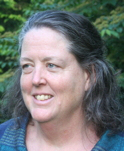
Ellen Larson.
After 20 years working as a writer and editor in Egypt, Ellen Larson was recently named editor of The Poisoned Pencil, the YA mystery imprint of Poisoned Pen Press. Ellen, who lives in an off-grid cabin, also writes. Her fiction has appeared in Yankee Magazine, Bloodroot Literary Magazine, Alfred Hitchcock’s Mystery Magazine (Barry Award finalist), and Big Pulp Magazine. Her dystopian murder mystery, IN RETROSPECT (Five Star Gale-Cengage), was released December 2013 to rave reviews.





Pride Week Guest Post from Jamie Johnson: My Son’s Story
Sometime into my son, Kip’s, engagement to Paige they felt the need to share his secret with her parents. It was the right thing to do. They didn’t want her parents to find out he was trans from someone else and feel hurt; they might think that Paige and Kip didn’t trust them enough to tell them.
So they scheduled a visit on a night when her brother, the only sibling still living at home, would be out at football practice.
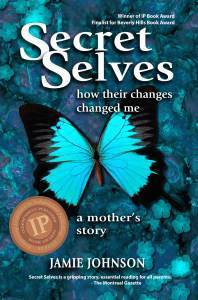
Transitions Studios, November 2011.
Kip was a wreck that night. I thanked heaven he had a strong heart, because he had wound himself tighter than a rope on a ship’s anchor. I was a bit tense myself. Sometimes it surprises me, how my feelings are still so connected to my children’s. It doesn’t seem to go away just because they grow into adults.
Early that evening the phone rang. I looked at the call display: Kip’s number. I hadn’t expected a call for another hour or two. Crap!I thought. What’s going on?!
Taking a deep breath, I picked up the receiver. “Hello.”
“They cancelled football practice.” Not even a hello, just an exasperated whisper.
“Oh, honey, what are you going to do?” I asked.
“I don’t know,” he whispered back, and then at fast-forward speed, said, “but we have to do it tonight.” He took a deep breath. “I’m ready… and I can’t go through this again.” He’d been having the conversation in his head all week and the stress of waiting for the time to come had almost brought him to the point of rushing over there and blurting it out.
“What if you go for a drive…or out for coffee?” I offered.
“Maybe. We’ll figure something out. I gotta go.”
“Well, good luck, honey,” I said sympathetically. I hung up the phone shaking my head. Murphy’s law. If something could go wrong for the poor kid, it would.
The next time the phone rang, I looked at the number and my heart seized. Paige’s parents. A flash of fear stopped me dead. Letting the answering machine take the call was a pretty attractive option at that moment. But I couldn’t do it. Whatever they had to say, I’d face it.
“Hello”
“Hi, Jamie. Kip just told us his story.” It was Paige’s mom.
“Hi, Suzanne,” I said, trying to prepare myself for anything. “Yes, I knew they planned to tell you tonight.”
Her voice came back in a determined, fluent tone. “I can’t tell you how strongly I feel about this.”
I took a deep breath and braced myself. Please God, please make them accept him. For the life of me, I couldn’t figure out what she meant or what I should say. So I just waited.
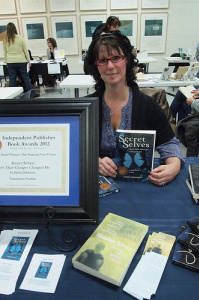
Jamie at a book fair.
“I’ve been trying to get Kip to go back to school for a long time. Now, I’m going to push even harder. The strength it must haven taken to go through what he’s been through, the whole transition process… well, now I know he can do it! I won’t give up now!”
I think I might have laughed at that point. I don’t know what I’d expected, but it sure wasn’t that! Kip had completed two college programs, but Rachel wanted him to go further.
Later that night, when Kip told me the story of telling his future parents-in-law, I learned that they’d shared his secret in very close quarters. Paige and Kip had squirreled her parents away to the back end of the house, into their pantry, as far away from ear-shot as possible. Kip said he felt like the walls were closing in on him, like he was in a closet. The room barely held the four of them.
When I imagined this, I could picture the sweat dripping down Kip’s forehead, him trying to wipe it away casually with his future in-laws only inches away, and then the confused look on his face if Suzanne had reacted the same way with him. I had to smile. What had seemed a scary, foreboding conversation hadn’t needed to be fear-inducing at all. It’s another good example that you just never know how people are going to react when faced with diversity.
Now, a couple of years later, when Kip and Paige go to visit her parents, they bring with them our bright eyed five-month-old grand-daughter. There is no awkwardness in the relationship. Nothing’s changed. Kip’s mother-in-law says all she ever wanted was for her daughter to feel happy and loved, and she has always felt that Kip is the right person to do that.
To me, the best part is that Kip and Paige can take their beautiful baby to visit her Granny and Grampa with an open heart and no feelings of regret.
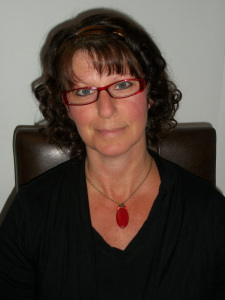
Jamie Johnson.
Jamie Johnson is an award-winning author who enjoys sharing the growth she experienced when raising her two very interesting children. Her memoir, Secret Selves, explores the most interesting years in their home: the years when her daughter became her son, and his younger brother shared his body with five alternate personalities. Jamie’s work has been published in several anthologies, magazines and newspapers. You can visit her website and blog at www.secretselves.net. She works alongside her husband in their unique antique/gift shop.





June 11, 2014
Pride Week Guest Post from Arin Andrews: I am Arin
I am Arin. I am also transgender. This does not tell you much about me, nor should it. This is just a small piece of who I am. Being a transgender boy from Oklahoma has been a journey that I wouldn’t trade for anything. I was brought up to be honest — not only to others, but with myself. The hardest struggle of discovering who I really am was the internal battle I had within my own heart and soul and the core of my beliefs. I think in the process of understanding where I stand on my sexuality and gender I managed to come out of every closet door in the house.
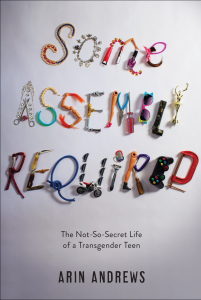
Simon & Schuster Books for Young Readers, September 2014.
As a young girl, I knew I didn’t fit the mold. My mom had me in cheerleading, dance and pageants. I did them with a smile on my face, but underneath…the storm was brewing. I thought that maybe I was gay. As soon as I realized calling myself a lesbian would imply that I was a girl that this was definitely not how I saw myself. I certainly didn’t want the world seeing me as a girl either. That just didn’t feel right. I continued reading and researching. I discovered the word transgender. When I read the description, it fit me. Problem solved, label attached. Well, not so fast. So now that I had figured out I was a boy, not a girl, I thought that I obviously must like girls. This scenario didn’t work either. I dug a little deeper and decided to explore the idea that YES — I do like boys. I have always thought they were cute, but when I was younger, and they kissed me as a girl, well, this just felt so weird. I needed to be seen by the world for the boy that I was…and I also discovered that it was perfectly fine to like boys and be a boy.
I know this all sounds crazy to most you and, well, it kind of is. I had to dig deep to get where I am at today. I will give you a recap from my dating experience thus far: I dated boys when I was a girl named Emerald. I dated a girl when I was a girl named Emerald. I dated a girl as a boy named Arin. Currently I am dating a boy as a young man named Arin. That is four doors that have been opened and explored. Now you see why all the closet doors have been opened in my house. I have been every color of the rainbow flag.
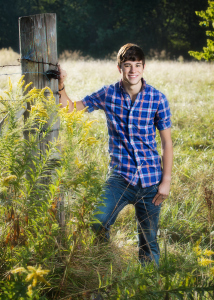
Arin Andrews. (Photo by Nancy Poole Photography.)
I feel like labels are a starting point but should never be the end-all to someone’s identity. This part of my self-discovery is another reason that my life has felt like something that needs to be assembled. I wrote my first book, a memoir of my experience called SOME ASSEMBLY REQUIRED: The Not So Secret Life of a Transgender Teen. My hope is that I give others inspiration to laugh along the way, even through the tough times. It’s not easy being a teenager –especially with the extra complications of things not fitting together right. This may take a little work and a little elbow grease to get through it all. Hang in there, because it is all worth it in the end. Just keep laying one brick at a time in front of your path and taking a step. One brick at a time. Be patient with yourself and your loved ones. It is not easy charting a new path that is not black and white, even if instead it’s a beautiful rainbow. Discovering who you are takes work. Don’t ever be ashamed or afraid of who you are. Everyone is designed the way they are supposed to be. Just be proud of stand tall.
Arin Andrews graduated from high school in 2014. He enjoys hiking, camping, and motocross. SOME ASSEMBLY REQUIRED is his first book. Arin lives in Oklahoma.





Pride Week Guest Post from Deborah Ellis: What Matters
One of the benefits of writing for young people is getting invited into schools. For the last decade I’ve been welcomed into schools across North America, Asia and Europe. Speaking with kids about books, reading, world issues and how we can learn to make better choices that will result in a kinder planet is a real challenge and joy for me.
I’ve done a lot of this and am quite comfortable talking about the themes of many of my books – such as the damage war does to people and society, the crime of allowing diseases like AIDS and leprosy to go untreated when the planet has the resources to get the medication to everyone who needs it. But with my latest book, MOON AT NINE, I’ve been nervous.
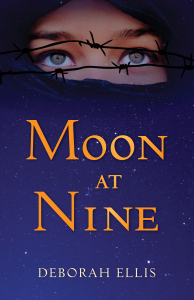
Pajama Press, June 2014.
I am a 53 year old lesbian. This is something I embrace with joy and pride, but have not talked about it in schools. Partly, this is because I am invited in by a teacher who uses my books in her classroom, and once I leave, she has to deal with the fall out of the visit. She’s been kind to me so I want to not make her life more difficult in return. The other reason I don’t talk about it is that it does not naturally come up in a presentation. Sometimes I’ll get a question about whether or not I have a husband, and all I say to that is “no”.
But MOON AT NINE is different. It is based on the true story of two teenaged girls in Iran in l988. These girls attend a school for gifted girls in Tehran. They form a very close friendship and they fall in love. And people find out.
In the Iran of l988, just like the Iran of today, being lesbian or gay is against the law. There are over 70 countries today where this is the case, where who you are and who you love can land you in jail for a very long time, perhaps even the rest of your life. In seven countries, including Iran, being lesbian or gay can land you the death penalty. It is estimated by human rights organizations that since l979, over 4000 lesbian and gay Iranians have been put to death. I don’t expect they had much of an easier time before l979, during the reign of the murderous Shah.
I was faced with a choice when I talked about this book – to keep the talk to the book, and therefore removed from myself, or to talk about my own experience of being lesbian. I wasn’t sure what I would do.
The first school I went to after MOON AT NINE came out was a Catholic school in a small city in Ontario. The sixth, seventh and eighth grades were assembled in the gym. The portion of the talk about war was over. I held up MOON AT NINE, with its striking blue cover, and wondered what would come out of my mouth.
“My wife has cancer,” I said. “She is in the middle of chemotherapy. We go back and forth to the cancer hospital in Hamilton, and on each visit, when they check her in against the information they have in their charts, they say, ‘And your partner, Deborah Ellis, is here with you. Excellent.’ They don’t make her lie, they don’t make her feel ashamed, and I am welcomed into the waiting rooms and chemo suite with the same grace and gentleness that husbands, fathers and mothers are. I am treated just the same, and, more important, my wife is treated just the same. This came about because of decades of struggle and work by the people who went before us. And in many countries, being lesbian or gay can still get you killed.’”
The book was shaking in my hand as I spoke, and I was sure my heart was beating loud enough to drown out my words. I said a few more words about the writing of MOON AT NINE, then I took questions.
There was silence in the room. No hands went up. I feared the worst, that my bombshell was going to get the microphone yanked out of my hand, I’d be booted out to the parking lot and the teacher who so kindly invited me would lose her job.
Then I saw a hand.
I managed a smile and a nod that the kid should ask his question.
“So – why did you want to become a writer?”
A normal question from a kid at an assembly. I answered him. Another hand went up.
“How many books have you written?”
Another normal question.
“Do you draw your own covers?”
It went on and on. The questions were about writing and war and did I have any pets? Nobody asked about me being lesbian.
They just didn’t seem to care. My being lesbian was the least interesting thing to them. There was the whole world to talk about, so we talked about that instead.
At the very end of the session, as kids were filing out of the gym to go back to their classrooms, a tiny little girl came up to me. She was one of the great readers from grade 4 that had been allowed to come to the assembly. I had to bend down to hear her quiet voice.
“I hope your wife gets better,” she said. I almost cried.
I owe so much to all those who went before us, paving the way for me to be able to live my life openly and honestly. I owe so much to all those who are today continuing to fight the good fight for liberty and justice for all.
Happy Pride, everybody!
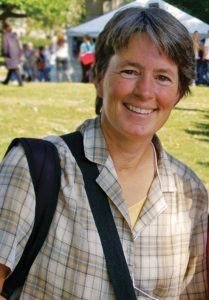
Deborah Ellis.
Deborah Ellis is the internationally acclaimed author of nearly thirty books for children and young people, most of which explore themes of social justice and courage. A peace activist, feminist, and humanitarian, Deborah has won many national and international awards for her books, including the Governor General’s Award, the Ruth Schwartz Award, the Vicky Metcalf Award, the American Library Association’s Notable List, and the Jane Addams Children’s Book Award. In 2010, she received The Ontario Library Association President’s Award for Exceptional Achievement. Deborah lives in Simcoe, Ontario, with her wife.





June 10, 2014
Pride Week Guest Post from Kirstin Cronn-Mills: Holding the Space
Being an ally to the LGBTQ community can be a complex situation. The word “ally” has the synonyms of “associate,” “colleague,” “friend, “ “confederate,” “partner,” and “supporter.” Being a friend is a good thing, yes? Friends are always welcome! Well, not always, and for good reason. When you have privilege (me) and you’re trying to be a colleague or friend to someone who doesn’t have privilege (anyone in a marginalized community), you can automatically look like an enemy, no matter your intentions. And you can do stupid stuff that reflects your privilege, even when you’re trying not to be an idiot.
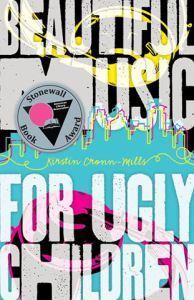
Flux Books, October 2012.
Some LGBTQ folks like having allies in their community, which is great fun. I get to meet new people, learn new things, and hang out with the cool kids. Some folks really hate allies and think we’re just cookie-seeking jerks, looking for a pat on the head. I understand that position, too, and I have met people who claim to be allies only to make themselves look good. Some folks are neutral about us, some don’t know what to think, and some are a mix of all the feels.
It makes sense, all the mixed-up thoughts and feelings—sometimes there’s a weird “so you think we need help, huh?” vibe when allies are present, and it’s uncomfortable. Allies aren’t perfect. I’ve been an ally for over twenty years, and over that time I have helped, I have hurt, I have screwed up, and I have learned. Every day is a new day to practice. After years of trying to figure out how to “do it right” (which varies from situation to situation and person to person, of course), I’ve finally decided that the best thing I can do—every time—is to create a safe space, then take my cues from the people in that space.
If a person who is LGBTQ wants me to be their friend, I’m up for that. If they need help, I’m here. If they want me to stay out of their way, I will. Whatever they need, I’m on it. But I make sure that, if I’m in ever charge of a space—a classroom, a meeting, a book event—it’s always a safe space for LGBTQ individuals. Always. No slurs, no jokes, no power plays, no stupidity. Just a safe, open space for people to be themselves.
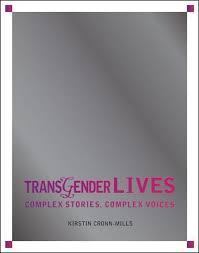
21st Century Books, September 2014.
My ally life has a lot of forms. Sometimes I’m supporting family, friends, colleagues, and students. Sometimes I’m reminding my fifteen-year-old son that the homophobic culture surrounding teenage boys is not OK (“Really? You want to disrespect your Uncle Daisy like that?”). Sometimes I’m writing books. But always I’m trying to hold the space, no strings attached. I do it because all humans deserve that respect, and because I want the same thing for myself—I want to be loved for who I am. So it’s my job to create a physical, mental, and emotional place for that to happen for others.
Want to talk politics? I’m in. Want to shoot the bull about TV? I can do it all day. Want to sit quietly and just be? Excellent. Want me out of the room for a queers-only space? I’ll watch the door for you—on the other side of it. I wanted an ally when I was a teen and I didn’t manage to find one, so that feeling of needing someone to have my back is never far from my heart. Now it’s my job to be that person. Do for others as you would like done for you.
All of this is to say: I have your back, LGBTQ community, in whatever way you need me. I’m not perfect, but I’m teachable, and no matter how you feel about me, I have your back.
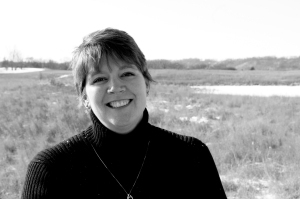
Kirstin Cronn-Mills.
Kirstin Cronn-Mills is a writer and a teacher who lives in southern Minnesota with her spouse and teenage son. Her first young adult novel, THE SKY ALWAYS HEARS ME AND THE HILLS DON’T MIND, was a finalist for a Minnesota Book Award in 2010. Her second novel, BEAUTIFUL MUSIC FOR UGLY CHILDREN, won a 2014 Stonewall Award from the American Library Association. Her first nonfiction YA book, TRANSGENDER LIVES: Complex Stories, Complex Voices, comes out in September.





Pride Week Guest Post from Robin Stevenson: Diversity in Children’s Novels — More Queer Families Please!
When I first came out, more than twenty years ago, there weren’t many queer characters in teen novels. One could probably count the books on two hands—Sandra Scoppetone’s TRYING HARD TO HEAR YOU (1973) and HAPPY ENDINGS ARE ALL ALIKE (1978), Nancy Garden’s ANNIE ON MY MIND (1982), Francesca Lia Block’s wonderful WEETZIE BAT books, and a handful of others.
And now? We’ve come a long way. There are some fabulous YA novels out there with lesbian, gay, bisexual, queer, questioning and transgendered characters– and lots of terrific new books come out every year.
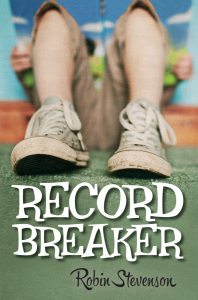
Orca Books, March 2013.
There are some very powerful novels about coming out, about identity, about loves and losses, about changes and challenges in relationships with family and friends and peers. And we need more of these novels. Despite what some have suggested, coming out novels have NOT been “done to death” any more than YA novels about heterosexual relationships.
But—and this is perhaps even more exciting– we’re now seeing more and more novels where the character’s (queer) sexuality and identity are incidental to the story. We’re seeing fantasy and sci-fi as well as contemporary fiction. And I suspect we’ll continue to see more and more of these novels—which is awesome. And even for kids in middle school, twelve and thirteen year olds, we’re starting to see a few more books with queer characters.
But what we are not seeing—what barely even exists—is any representation of queerness in fiction for younger readers. There are so many wonderful books for kids who eight to twelve, kids who are reading independently and well in to chapter books and juvenile novels, but not yet ready for YA—but so few of these books include queer characters.
After hunting around online, I’ve found a few: Lauren Myracle’s LUV YA BUNCHES includes a character who has two moms, which has caused an absurd amount of controversy. DAYS THAT END IN Y is the third in a series about two kids, Clarissa and Benjy, and includes a story line which sees Benjy starting to understand more about himself and finding the courage to come out. And its author, Vicky VanSickle, rounded up a few more in this great blog post. But that’s about it. If anyone knows of others, please let me know in the comments!
I think the problem is that queerness often gets equated with sexuality, and while people generally accept that figuring out sexuality is a part of adolescence, anything even vaguely sexual is seen as inappropriate in books for younger readers. Which is debatable, of course- I have many friends who knew they were gay- or at least, different- at a very young age, long before they even knew there was a word for it. Some of them struggled hugely as young kids and maybe books could have helped reduce their fear and isolation.
But regardless of where you stand on that question, queerness isn’t just about sexuality. It’s also about families—and I don’t think anyone would disagree that families exist and belong in books for readers of all ages.
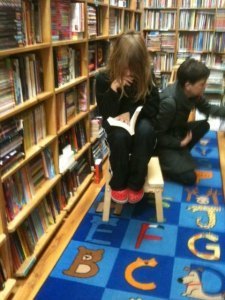
So many books, so few queer families.
My son is nine and loves books, especially fantasy and sci-fi. He has two moms– and he has yet to read a chapter book which includes a family that looks like his. NOT. ONE. SINGLE. BOOK. His bedroom is lined with over-flowing bookshelves and in every single one of those books, the characters—thousands of them- are all, apparently, straight. Every last character- be it human, mouse, monster, cat or alien. What is up with that?
Children should find themselves and their families reflected in what they are reading—and they shouldn’t have to wait until they are old enough to read teen novels.
And as a children’s author, I am part of the problem. Of the sixteen books I have published, nine are for teens- and three of those (INFERNO, OUT OF ORDER and BIG GUY) have queer main characters. INFERNO was even a 2010 Rainbow List selection, which I was thrilled about.
But seven of my novels are for younger readers- and of those, none have a queer main character. And only one- Liars and Fools- even has minor character who is queer (Fiona’s aunt lives with a gay male friend, Tom, who Fiona considers an uncle).
Obviously I need to do something instead of just complaining. We need more diversity in children’s books, not just in YA. So come on, kid lit writers. It’s time for a change. Let’s make it happen.
And for all lovers of diversity in children’s books and teen fiction, here are some ways you can help.
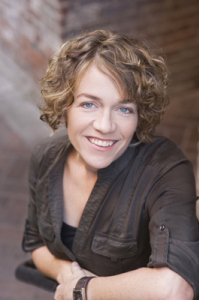
Robin Stevenson.
Robin Stevenson is the author of sixteen novels for teens and children, including the 2014 Silver Birch Award winner RECORD BREAKER. Her YA novels include A THOUSAND SHADES OF BLUE, HUMMINGBIRD HEART, INFERNO and Escape VELOCITY. Robin was born in England, grew up mostly in Ontario, spent a couple of years in Australia, and now lives on the west coast of Canada, with her partner and their ten year old son. She writes, edits, and teaches creative writing courses for people of all ages. Robin loves hearing from readers and can be reached through her website at www.robinstevenson.com.





June 9, 2014
Pride Week Guest Post from Amy Dunne: Books Made Me Feel Less Alone
I’m fairly new to writing. My debut YA novel, SECRET LIES was published in December 2013. It’s a lesbian romance and coming out story. It took years of hard work and perseverance, but my dream of becoming a published author finally came true.
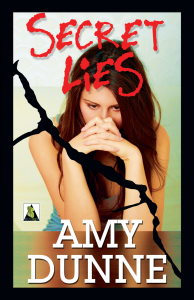
Bold Strokes Books, December 2013.
My inspiration for writing SECRET LIES came while I was working with vulnerable young people in care. I wanted to write a YA book that gave a realistic insight into the lives of young lesbian, bi, and queer women, but that also didn’t shy away from the real issues that affect them. As well as the obvious ones; sex, partying, independence, relationships with parents and religion, plans for the future, sexuality, peer pressure, alcohol and drug use, there are two other issues explored that are both dark and gritty in content. Self-harm and abuse. (Trigger warnings for both).
I’d written a short story for my school English assignment when I was sixteen. I always knew that it was this story, that I would one day write as a full-length novel and hopefully get published.
Having two seventeen year old protagonists gave me a wide scope to explore. At seventeen you’re so close to being an adult but frustratingly not close enough. You crave independence but don’t want to be considered different. Physical, psychological, and emotional changes are all wreaking havoc. There’s pressure to conform to the demands of peers, family, religion, and community. Sexuality and an increased interest in sex all come with their own additional pressures.
Honestly, I’m so very proud of how SECRET LIES turned out. It’s has some great feedback and is even a finalist in the YA category of the 2014 Golden Crown Literary awards.
However, my confidence in SECRET LIES and my writing abilities recently took a battering. I attended a literary event a few months ago and was happily talking with a small group of people. Some of whom I knew and some I didn’t. One person, who classed themselves as being learned in all things literary, asked what I did for a living.
Saying I’m a lesfic author is still something I’m getting used to and honestly, I still find it a little daunting. You’re never entirely sure what reaction you’re going to get.
The silence was deafening and the limelight blinded me. I could feel the group’s eyes watching me. I was honest and said that I’m a lesfic author and my debut novel had recently been published.
Before anyone else had a chance to speak, the person asked what my novel was about. I said it was a Young Adult story with lesbian protagonists. I was about to continue speaking when the same person cut me off.
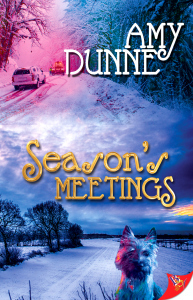
Bold Strokes Books, December 2014.
With a dramatic disapproving sigh, they went onto say they hoped it wasn’t just another coming out story. In their not so humble opinion, that particular subject had been covered to death to the point it was now tediously boring. Without bothering to pause for breath they continued. Apparently, coming of age books aren’t needed anymore because it’s so much easier for LGBTQ youth to come out these days. This person predicted in the not so distant future coming of age stories wouldn’t be needed or read at all. They then announced their spectacularly ignorant finale, “young people don’t even read nowadays.”
I was stunned and appalled in equal measures. In hindsight I imagine I looked like a floundering fish. My mouth gaping but all of the words I wanted to say had clogged up my throat and nothing was coming out. I remember looking around the group and seeing mirrored looks of surprise and a few sympathetic glances aimed in my direction.
Now, I don’t suffer fools gladly. I’ve also never been one to keep quiet in the face of adversary. Anger coursed through my veins and I quickly decided I had plenty to say and this person was going to hear it all.
Luckily for my intended victim (who incredibly remained oblivious to my seething temper and the scathing retort that I was spluttering to voice), they were called away to talk to some other unfortunate soul.
I never did get to set the record straight and so I decided this blog is the perfect opportunity to do just that.
I accept (begrudgingly) that everyone is entitled to their opinions. I do however, find it frustrating that someone can make such sweeping generalisations about young people. I can’t fathom how someone could nonchalantly say that young people don’t read nowadays. If that was the case, why is YA fiction so huge?
People read for many reasons; to learn, for enjoyment, for entertainment, for comfort, to feel represented, and for escapism. When I was young I read all sorts. I was secretly trying to find a character and story that I could relate to in someway and perhaps even feel I was represented in the pages. This didn’t happen until my early twenties when I purchased my first lesfic book. It changed everything for me and made me appreciate the truth value and importance of LGBTQ books.
To say that coming out stories are tedious and have been done too much, is something I find absurd. I suspect that same person wouldn’t say, “I’m sick of reading romances. They’re all the same thing. Characters like one another, fall in love, something messes it up, and then they get back together at the end. Therefore, authors should stop writing romances.”
If a young person doesn’t want to read a coming out story, they’ll pick up a different genre to read instead. That doesn’t mean that every young person in the world doesn’t read or enjoy them.
In a perfect utopia where equality rules, coming of age stories might not be so important. But we don’t live in a perfect utopia. The LGBTQ community have made huge strides in the progress for fighting for equality, but there’s still so much more to do. Our fight is now global. We have to speak for those LGBTQ people who aren’t allowed voices and risk their lives simply for being who they are. Just look at Russia and Uganda!
In the future if equality is finally unanimous, then I accept that coming out stories may not be written as often. That wouldn’t be any less important and they wouldn’t disappear from the face of the earth. Why? Because they provide an integral insight into another part of our LGBTQ history. They voice the trials and tribulations our young people face.
We wouldn’t demand that people don’t write or read about historical accounts of minorities, just because those times have changed. The same goes for coming out stories.
I’m proud that there’s a wide variety of LGBTQ YA fiction in publication, including coming out stories. If I’d read one back when I was young, I’ve no doubt it would’ve helped me come to terms and accept my sexuality much earlier on. It would have also given me the solidarity I so desperately craved at the time.
Returning to what that person said to me. I also took particular offence at their comment that it’s easy for young people to come out nowadays. Each person’s experience of accepting their sexuality and coming out, is deeply personal and unique to them. To say otherwise is to diminish that person’s experiences, emotions, and thoughts. Just because in some countries on the surface it’s generally more socially acceptable to come out as LGBTQ nowadays, doesn’t mean that’s a universal truth.
Regardless of age, coming out can be a very daunting prospect. You run the risk of being rejected by loved ones and your community. For young people who are totally reliant on their family, live in a religious close-knit community, and have heterosexual peers, the thought of coming out is terrifying.
Coming out stories can be a lifeline in an otherwise bleak and lonely world. They show there is a brighter world beyond the high school years. You’re not alone. Who you are and who you love isn’t wrong or sinful. And above everything else, they show that unconditional acceptance, love, and happiness are definitely possible in the future.
So, in conclusion to that person who voiced your opinions, here are my final thoughts. Young people love to read and that’s why YA fiction is so phenomenally successful. Coming out is deeply personal for each individual, and takes enormous courage and strength. Coming of age stories are still important today and will be always be a part of our literary history. And finally, I’d rather spend my time talking to young people any day of the week, than I would having to listen to your drivel again.
Yours Sincerely,
A very proud author of lesbian YA fiction.
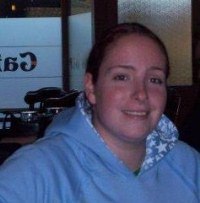
Amy Dunne.
Amy Dunne was raised in Derbyshire, England. She attended Keele University and graduated in 2007 with a BSc in philosophy and psychology. After graduating, she worked for a while with vulnerable young people until she moved on to delivering adult training courses. She is currently in the process of setting up her own business, which is an exciting prospect. She is engaged to her lovely partner, Lou, who is also a massive fan of Dolly Parton. They have two gorgeous cats and a very naughty puppy.






